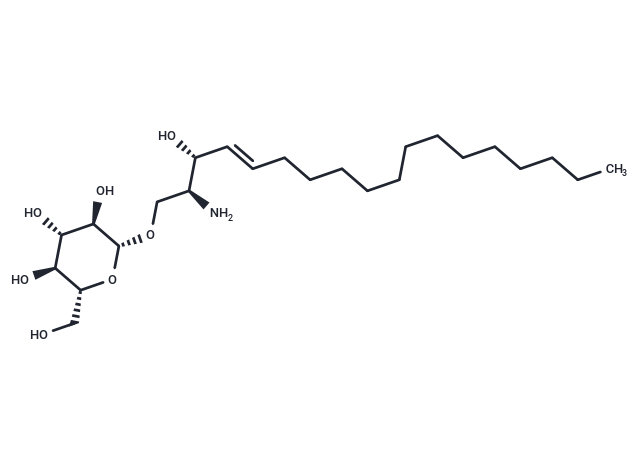Shopping Cart
- Remove All
 Your shopping cart is currently empty
Your shopping cart is currently empty

Glucosylsphingosine (Lyso-Gb1) is a naturally occurring glycosyl ceramide, a metabolite of GBA (acid β-glucosidase), involved in cellular recognition, signaling, and intercellular interactions.Glucopsychosine accumulates in certain neurodegenerative diseases (e.g., Gaucher disease), disrupts lysosomal function through activation of mammalian target of rapamycin complex 1 (mTORC1), and is a noncompetitive inhibitor of glucocerebrosidase.

| Pack Size | Price | Availability | Quantity |
|---|---|---|---|
| 1 mg | Inquiry | 35 days | |
| 5 mg | Inquiry | 35 days |
| Description | Glucosylsphingosine (Lyso-Gb1) is a naturally occurring glycosyl ceramide, a metabolite of GBA (acid β-glucosidase), involved in cellular recognition, signaling, and intercellular interactions.Glucopsychosine accumulates in certain neurodegenerative diseases (e.g., Gaucher disease), disrupts lysosomal function through activation of mammalian target of rapamycin complex 1 (mTORC1), and is a noncompetitive inhibitor of glucocerebrosidase. |
| In vitro | Methods: MCF7 cells were treated with glucosylsphingosine (20-45 μM, 48 hours), and cell death was determined by PI and Hoechst-33342 staining. Results: Glucosylsphingosine killed MCF7 cells independently of apoptosis, ferroptosis, and necroptosis, and induced cell death in a dose-dependent manner, with an LC50 of 33 μM.[4] |
| In vivo | Methods: Adult male C57BL/6JRj mice were treated with glucosylsphingosine (10 mg/kg, subcutaneous injection, daily, for 12 consecutive weeks) and the inflammatory changes in the mice were observed. Results: Glucosylsphingosine accumulated in peripheral tissues and induced hematological symptoms in mice, such as decreased hemoglobin and hematocrit, increased spleen weight, and mild inflammatory tissue reactions, indicating that it induced visceral inflammatory reactions in mice. [6] |
| Alias | Lyso-Gb1, Glucosyl-C18-sphingosine, Glucopsychosine, 1-β-D-Glucosylsphingosine |
| Molecular Weight | 461.63 |
| Formula | C24H47NO7 |
| Cas No. | 52050-17-6 |
| Smiles | O(C[C@@H]([C@@H](/C=C/CCCCCCCCCCCCC)O)N)[C@@H]1O[C@H](CO)[C@@H](O)[C@H](O)[C@H]1O |
| Storage | keep away from direct sunlight | Powder: -20°C for 3 years | In solvent: -80°C for 1 year | Shipping with blue ice. | |||||||||||||||||||||||||||||||||||
| Solubility Information | H2O: 100 mg/mL (216.62 mM), Sonication is recommended. DMSO: 80 mg/mL (173.3 mM), Sonication is recommended. | |||||||||||||||||||||||||||||||||||
Solution Preparation Table | ||||||||||||||||||||||||||||||||||||
DMSO/H2O
| ||||||||||||||||||||||||||||||||||||

Copyright © 2015-2025 TargetMol Chemicals Inc. All Rights Reserved.